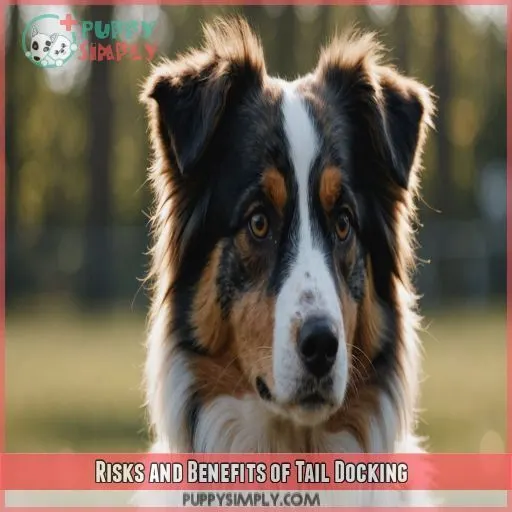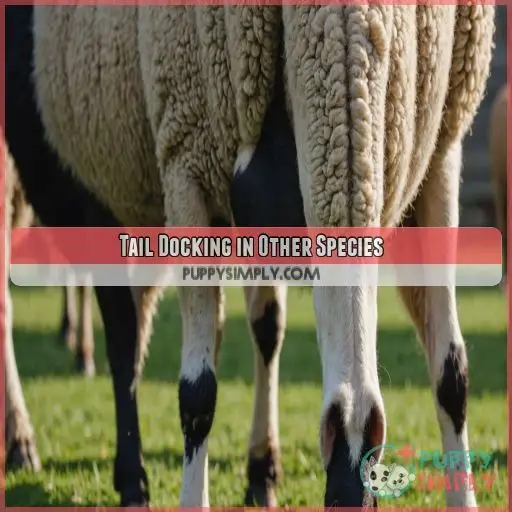This site is supported by our readers. We may earn a commission, at no cost to you, if you purchase through links.

Historically, Tail docking was done to prevent injuries during herding, but many countries have banned it for cosmetic purposes.
The truth is, a shorter tail doesn’t guarantee injury prevention, and regular grooming can help spot potential problems early on.
If you’re concerned about your Aussie’s tail, consider their individual needs and lifestyle. Are they a working dog or a pet? Weighing the pros and cons is important.
Let’s explore the ins and outs of tail docking and what it means for your furry friend.
Table Of Contents
- Key Takeaways
- Tail Docking History and Controversy
- Aussie Tail Genetics and Traits
- Communication and Health
- The Fi Dog Collar: Monitoring Health
- Arguments for and Against Tail Docking
- Legislation and Breed Standards
- Dewclaw Removal: Similarities and Differences
- Risks and Benefits of Tail Docking
- Tail Docking in Other Species
- Responsible Decision-Making
- Frequently Asked Questions (FAQs)
- Should Australian Shepherds tails be docked?
- Do vets recommend tail docking?
- How long does it take for a dog’s tail to heal after being docked?
- Does tail docking prevent injuries?
- Can tail docking prevent injuries in working Australian Shepherds effectively?
- How does tail docking impact Australian Shepherd athletic performance overall?
- Are tail injuries more common in certain Australian Shepherd activities?
- Can Australian Shepherds adapt to tail docking without behavioral issues?
- Is tail docking necessary for preventing infections in Australian Shepherds?
- Conclusion
Key Takeaways
- Tail docking is a controversial topic, and it’s banned in many countries due to animal welfare concerns. It’s essential to weigh the pros and cons, considering your Aussie’s individual needs, lifestyle, and breed characteristics.
- Regular grooming and safe exercise routines are effective alternatives to tail docking for injury prevention. These practices help keep your Aussie’s tail healthy and can reduce the risk of tail injuries.
- The T-gene mutation is responsible for the natural bobtails seen in some Australian Shepherds. This mutation affects tail growth and development, resulting in varying tail lengths within the breed.
- Communication, health, and ethical considerations are essential factors in the tail docking debate. The procedure may impact a dog’s ability to communicate, and there are potential health risks, so it’s crucial to make informed decisions in collaboration with veterinarians.
Tail Docking History and Controversy
You’re probably wondering why some Australian Shepherds have naturally short tails, while others have their tails docked – and whether it’s really necessary. Let’s explore the fascinating history and controversy surrounding tail docking, from its origins to the heated debates about animal welfare and the banning of non-therapeutic docking.
Origins of Tail Docking
Let’s explore the world of tail docking in Australia. This practice, you might wonder about its origins, has roots in ancient times, with various reasons behind it. Here are a few key points to keep in mind:
- Ancient Roman influence: The Romans believed docking could prevent rabies.
- Hunting dog tradition: Docking was thought to prevent tail injuries during hunting.
- Breed standards: Many breed standards required docking.
- Aesthetic purposes: Breeders started docking for cosmetic reasons, shaping breed standards.
- Veterinary opposition: As animal welfare concerns grew, vets began speaking out against non-therapeutic docking.
Reasons for Docking
You’re probably wondering why tail docking was a thing in the first place. Historically, working dogs, like Australian Shepherds, had their tails docked to prevent injuries while herding or hunting. Traditional practices and breed standards also played a role. However, as our understanding of dog health evolves, so do our concerns about the ethics of tail docking.
Animal Welfare Concerns
You’re likely concerned about the ethics of tail docking, and rightly so! The procedure raises serious animal welfare concerns, as it can cause unnecessary pain and risk complications. As you consider the best approach for your Aussie, remember that alternative solutions like regular tail care and safe exercise can minimize the risk of tail injuries.
Banning of Non-Therapeutic Docking
You’re likely aware that many countries, including Australia, have banned non-therapeutic tail docking due to animal welfare concerns. This shift is largely driven by public opinion and ethical implications, rather than scientific evidence. As an Australian Shepherd owner, you need to think about the legal challenges, breed standards, and owner rights surrounding tail docking, a now widely considered cosmetic surgery.
Aussie Tail Genetics and Traits
You’re probably curious about the unique characteristics of your Australian Shepherd’s tail, and understanding the genetics behind it can help you better appreciate their natural traits. Let’s explore how the T-gene mutation affects their tail length, and what it means for their overall health and well-being.
The T-Gene Mutation
You’re now familiar with the controversy surrounding tail docking. But have you ever wondered what makes some Australian Shepherds naturally bob-tailed? It all comes down to the T-gene mutation. Here are three key things to know:
- The T-gene is responsible for natural bobtails: A mutation that affects tail growth and development.
- Not all Aussies have the T-gene: Its prevalence varies within the breed.
- Testing for the T-gene is possible: Helping breeders make informed decisions.
Inheriting the Bobtail Trait
To get a bobtail Australian Shepherd, both parents need to pass on the T-gene.
Even if your Aussie inherits the T-gene from just one parent, they might still have a full-length tail.
Breeding bobtails can be a bit of a genetic gamble.
It’s important to understand the Australian Shepherd genetics at play to make sure you have healthy, happy tails.
Variations in Tail Length
As you explore the fascinating world of Aussie tail genetics, you’ll notice that tail length can vary greatly – from almost nonexistent to a full-length tail.
This variation is due to the bobtail gene, which can be inherited in different combinations, resulting in a range of tail sizes.
It’s not uncommon to see Aussies with medium-length tails or even a "stub" tail.
Natural Bobtails in Other Breeds
You’re probably curious about other breeds with natural bobtails. Well, you’re not alone! Breeds like the Australian Stumpy Tail Cattle Dog, Pembroke Welsh Corgi, and Brittany Spaniel also have a high prevalence of natural bobtails due to their unique genetics. Just like Australian Shepherds, these breeds have adapted to their environment in amazing ways.
Communication and Health
When you get to know Australian Shepherds, you’ll discover that their tails are really important for how they communicate with each other, showing things like happiness, fear, and being on alert. By understanding how tails work in communication and health, you’ll be better equipped to make good decisions about your Aussie’s care and well-being.
Role of Tails in Canine Communication
As you interact with your Australian Shepherd, you’ll notice their tail plays a significant role in canine communication.
It’s not just a cute wag – it’s a key language cue.
By paying attention to tail position, movement, and context, you can better understand your dog’s needs and emotions.
This helps you respond appropriately, strengthening your bond and fostering a more harmonious relationship.
Emotions Expressed Through Tail Language
You’re probably familiar with the way your Aussie’s tail wags excitedly when they see you, but did you know their tail language can convey a range of emotions? Here are some variations to look out for:
- A relaxed Aussie might’ve a slightly wagging tail
- An agitated or scared Aussie may tuck its tail between its legs
- A fast, wide wag indicates happiness and excitement
- A stiff, straight tail can signal alertness or potential aggression
- A tucked tail can also indicate submission or fear
Health Implications of Tail Docking
Tail docking is a topic that comes up a lot, and you’re probably wondering about the health effects. Let’s break it down.
| Health Implication | Risk Level | Description |
|---|---|---|
| Pain | High | Acute pain during and after procedure |
| Communication Issues | Medium | Potential impact on canine communication |
| Incontinence | Low | Limited research suggests possible link |
While some risks are associated with tail docking, it’s important to weigh these against the potential benefits, especially for working dogs. However, for most Australian Shepherds, the risks may outweigh the advantages. It’s important to think about your dog’s individual needs and talk to a veterinarian to make an informed decision.
Regular Grooming and Health Checks
Regular grooming is key to keeping your Aussie’s tail healthy. A consistent routine helps prevent matting, detects abnormalities early, and keeps those pesky parasites at bay. Here are 4 essential grooming tasks:
- Inspect and clean their ears weekly to prevent infections.
- Trim nails monthly to avoid overgrowth.
- Brush their coat regularly to prevent matting.
- Check for fleas and ticks daily to help prevent parasite problems.
The Fi Dog Collar: Monitoring Health
As you care for your Australian Shepherd, you’ll want to think about the latest technology that can support their overall health and well-being, including their tail health.
The Fi Dog Collar is a valuable tool that offers activity tracking, GPS tracking, and insights into your dog’s daily life.
This technology can help you stay on top of your dog’s needs and make informed decisions about their care.
Activity Tracking and Insights
You’re probably curious about your Aussie’s daily activities. The Fi Dog Collar’s activity tracking feature provides valuable insights into their health trends, behavior patterns, and exercise levels. By analyzing this data, you’ll gain a better understanding of your dog’s needs, enabling you to make informed decisions about their care and identify potential health issues early on.
GPS Tracking for Safety
When hiking with your Aussie, GPS tracking for safety is a no-brainer. Imagine the panic of losing your furry friend in the wilderness! The Fi Dog Collar’s GPS feature keeps you connected, providing real-time location tracking. Whether traveling or exploring new trails, this tech helps keep your Aussie safe and gives you peace of mind, preventing lost dog nightmares.
Combining Technology With Nature
You’re embracing tech to support your Aussie’s health and happiness. Smart collars like the Fi Dog Collar combine technology with nature, providing activity tracking and GPS monitoring. It’s like having a personal assistant for your furry friend. With wildlife tracking and nature apps, you’re contributing to tech-powered conservation. AI for nature is changing the game.
Arguments for and Against Tail Docking
You’re about to enter the heated debate on Australian Shepherd tail docking, where passionate arguments for and against the practice will make you question its necessity. As you explore the historical reasons, preventive measures, and potential risks, you’ll discover why some swear by tail docking, while others vehemently oppose it.
Historical Reasons for Docking
You’re probably wondering why tail docking became a thing in the first place. Well, it all started with the Ancient Romans, who believed it could prevent rabies. Later, early hunting practices adopted docking to prevent injuries. The working dog tradition carried it forward, and breed aesthetics played a role too. Pedigree show rules even formalized it in the 1950s.
Preventing Injuries and Hygiene
You’re probably thinking about tail docking for your Aussie, wondering if it’s the right choice for preventing injuries and keeping things clean. It’s not a simple yes or no answer, so let’s break it down:
- Tail docking was originally done to help prevent injuries while herding or hunting.
- A shorter tail might reduce the risk of injury, but it’s not a guarantee.
- Regular grooming can help prevent mats and spot any potential problems early on.
- Working dogs might benefit from a shorter tail, but it’s not a necessity for pets.
- Ultimately, the decision to dock your Aussie’s tail should be based on their individual needs and lifestyle.
Pain and Risk Associated With Docking
As you weigh the pros and cons of tail docking, you need to think about the pain and risk involved. While some argue that docking is a quick and relatively painless procedure, others raise concerns about the potential long-term effects on your Aussie’s well-being. You’ll want to think about recovery time, anesthesia use, and the ethical implications of this decision.
Opposition From Veterinarians
You’re not alone in questioning tail docking – many veterinarians oppose it too. Their concerns include:
- Lack of scientific evidence supporting the procedure’s benefits.
- Pain management – is it really as painless as claimed?
- Breed standards prioritizing aesthetics over animal welfare.
- Ethical considerations – should we alter animals for human convenience?
Legislation and Breed Standards
When you look at Australian Shepherd tail docking, you’ll see that laws and breed standards have a big impact on how it’s done. From bans on docking tails unless there’s a medical reason to doing it, to changes in breed standards and pushback from breed clubs, it’s important to understand the complicated situation around this issue.
Bans on Non-Therapeutic Docking
You’re likely aware that many countries have banned non-therapeutic tail docking due to animal welfare concerns. These laws often cite the unnecessary pain and risk associated with the procedure. However, some argue that such regulations infringe on owner rights and may lead to increased tail injury rates in working dogs. The debate raises important ethical implications.
Amended Breed Standards
As tail docking bans take effect, breed standards are changing too. Here are four key changes you should know:
- No more docking for show: Many breed clubs now prohibit tail docking for dogs competing in the show ring.
- Emphasis on natural traits: Breed standards now focus on natural characteristics, rather than surgically altered ones.
- Health impacts considered: Breed clubs are prioritizing health and welfare over physical appearance.
- New judging criteria: Judges are now evaluating dogs based on their natural, undocked tails.
States Proposing Bills to Prohibit Docking
You’re probably aware that many states are proposing bills to prohibit tail docking. This move is largely driven by animal welfare concerns and a desire to update breed standards. The debate is heating up, with some arguing it’s an infringement on state rights and others seeing it as a necessary step in the right direction.
Opposition From Breed Clubs
As you explore the debate around tail docking, you’ll encounter opposition from breed clubs, who argue that legislation restricting docking infringes on owners’ and breeders’ rights. They claim that docking is a tradition that prevents injuries and maintain breed standards. You should think about the ethics of docking and the influence of breed clubs on this practice.
Dewclaw Removal: Similarities and Differences
When you’re thinking about Australian Shepherd tail docking, you might also wonder about dewclaw removal – a similar procedure often performed at the same age and for similar reasons. Let’s break down the reasons behind dewclaw removal, the incidence of dewclaw injuries, and the importance of open communication with your veterinarian to make an informed decision for your Aussie.
Reasons for Dewclaw Removal
You’re considering dewclaw removal for your Australian Shepherd. But why do owners opt for this procedure? Primarily, it’s to prevent injuries, especially in working dogs. Some breed standards also recommend removal. However, you should carefully weigh the pros and cons and consider your dog’s individual needs and lifestyle. Ultimately, the decision is yours, as the owner.
Incidence of Dewclaw Injuries
You’re curious about dewclaw injuries? While there aren’t specific studies on dewclaw injury statistics, online resources document numerous cases of dewclaw injuries and treatments. You should think about breed-specific risks, like Australian Shepherds, and the dewclaw’s function in their daily lives. By understanding these factors, you’ll be better equipped to make informed decisions about your furry friend’s health.
Decision-Making Process for Removal
You’re a responsible Aussie owner, and it’s time to decide about dewclaw removal. Here are key factors to think about:
- Owners role: Your values and priorities shape this decision.
- Vets expertise: Consult with a veterinarian to assess your dog’s needs.
- Ethical considerations: Weigh the pros and cons of this surgical procedure.
- Breed standards: Understand the breed’s history and traditional practices.
Importance of Open Communication
Dewclaw removal is a big decision for Aussie owners. Open communication between you and your vet is key. Discuss the risks and benefits, and consider your Aussie’s lifestyle and breed characteristics. By working together, you’ll make informed choices that prioritize their health and well-being.
| Considerations | Questions to Ask |
|---|---|
| Breed standards | Does my Aussie’s breed require dewclaw removal? |
| Lifestyle | Will my Aussie be engaging in activities that may lead to dewclaw injuries? |
| Health risks | What’re the potential health risks associated with dewclaw removal? |
| Alternative options | Are there alternative ways to prevent dewclaw injuries? |
| Owner-vet partnership | How will we work together to make informed decisions about my Aussie’s care? |
Risks and Benefits of Tail Docking
As you consider the risks and benefits of tail docking for your Australian Shepherd, you’re likely wondering if it’s truly necessary to prevent tail injuries.
Let’s weigh the evidence together, exploring the incidence of tail injuries.
We’ll also look at study findings on docking and injuries, potential negative consequences of docking, and alternatives to prevent injuries.
This will help you make an informed decision that’s best for your furry friend.
Incidence of Tail Injuries
You’re likely wondering how common tail injuries are. The answer might surprise you – studies show that only 0.23% of dogs experience tail injuries. This raises questions about the necessity of tail docking, especially for non-working dogs. Working dogs, like those used for hunting, may be more prone to tail injuries, but is docking the best prevention method?
Study Findings on Docking and Injuries
You’re weighing the pros and cons of tail docking for your Australian Shepherd. Let’s look at what the studies say. Research suggests that tail docking may not be as effective in preventing injuries as previously thought. Here are some key findings:
- A study found that only 0.23% of dogs suffered tail injuries, making docking seem unnecessary .
- Working dogs, like those used for hunting, may still be at risk of injury even with docked tails .
- Some breeds, including Australian Shepherds, can be born with naturally short tails, eliminating the need for docking .
- The American Veterinary Medical Association (AVMA) opposes tail docking for non-therapeutic reasons, citing animal welfare concerns .
Potential Negative Consequences of Docking
You’re weighing the pros and cons of tail docking for your Australian Shepherd. On the flip side, docking can have negative consequences, such as potential pain, communication issues with other dogs, and hygiene concerns. Additionally, some studies suggest it may affect behavior and overall health. You should think about these factors carefully when deciding what’s best for your furry friend.
Alternatives to Prevent Injuries
Considering the potential risks, you’re probably wondering if there are alternatives to prevent injuries. Yes, there are! Using tail wraps or protective gear can help safeguard your Aussie’s tail. Creating safe play areas and enrolling in breed-specific training can also reduce the risk of injury. Plus, being an aware owner can go a long way in preventing accidents .
Tail Docking in Other Species
As you consider the controversy surrounding Australian Shepherd tail docking, you might wonder how this practice compares to other breeds and species. Let’s explore the similarities and differences in docking practices, and what implications this has for your Aussie, especially if they’re a working dog.
Similarities With Other Canine Breeds
You’re probably wondering how Australian Shepherds compare to other breeds in terms of tail docking. Well, they’re not alone! Other herding dogs like Border Collies and Corgis can also be born with natural bobtails or undergo docking. In fact, many working dog breeds have historically been docked to prevent injuries, but bans on tail docking have changed the game.
Differences in Docking Practices
Tail docking is a topic that sparks different opinions depending on the breed. You might be wondering, what makes each breed’s practices unique? Let’s explore:
- Some breeds, like the Brittany Spaniel, have a high incidence of tail injuries, making docking more common.
- Others, like the Corgi, have naturally short tails, eliminating the need for docking.
- Larger breeds, like the Great Dane, rarely dock tails due to their size and strength.
- Regional variations, like in the UK, prioritize animal welfare, restricting non-therapeutic docking.
- Cultural impacts, such as historical hunting practices, influence breed standards and docking traditions.
Implications for Australian Shepherds
Let’s break down what tail docking means for your Australian Shepherd.
| Tail Type | Injury Risk | Docking Consideration |
|---|---|---|
| Natural Bobtail | Lower | Unnecessary |
| Short Docked Tail | Moderate | Dependent on lifestyle |
| Full-Length Tail | Higher | Important for working Aussies |
As an Aussie owner, you should carefully think about the risks and benefits of tail docking for your furry friend’s health and well-being. Consider their lifestyle, breed standards, and your responsibility as an owner to make an informed decision.
Considerations for Working Dogs
As you consider the implications of tail docking for your Australian Shepherd, you should think about working dog needs. If your Aussie is a herding dog, you may worry about tail injuries. However, many experts argue that ethical docking isn’t the solution. Instead, focus on training and breed standards that prioritize tail injury prevention.
Responsible Decision-Making
When considering tail docking for your Australian Shepherd, it’s important to weigh the potential benefits against the risks.
You should make an informed decision that prioritizes your dog’s health and well-being.
Staying informed on the latest research is crucial.
Communicating openly with your veterinarian is also important.
Finally, consider your dog’s individual needs and breed characteristics.
Considering Individual Dog Needs
When considering tail docking for your Australian Shepherd, think about their individual needs. Does their activity level put them at risk for tail injuries? Do they’ve specific health concerns that could impact their tail? Your lifestyle also plays a role – if you’re an avid hiker, a shorter tail might be beneficial. Weigh these factors carefully.
Breed Characteristics and Tail Docking
When considering tail docking for your Australian Shepherd, remember that breed characteristics play a significant role. Aussies with naturally short tails, or bobtails, are less likely to need docking. However, working dogs may benefit from docking to prevent injuries. Weigh the pros and cons, and think about your dog’s specific needs and lifestyle before making a decision.
Importance of Owner-Veterinarian Communication
Now that you’re aware of your Aussie’s breed characteristics, it’s time to have an open and honest chat with your veterinarian about tail docking. Discuss your concerns, and ask about the risks and benefits. This conversation will empower you to make informed choices that prioritize your dog’s health and well-being, while considering their unique needs and your personal values.
Staying Informed on the Latest Research
To make smart decisions about tail docking, it’s important to stay up-to-date on the latest research. This involves:
- Following reputable sources for scientific studies on tail docking
- Staying current with recent findings on the topic
- Considering the ethical implications of docking
- Consulting with vets for personalized recommendations
- Reviewing breed-specific research for a deeper understanding
Frequently Asked Questions (FAQs)
Should Australian Shepherds tails be docked?
You’re wondering if your Australian Shepherd‘s tail should be docked? Honestly, it’s a complex issue with strong arguments on both sides. Consider your dog’s lifestyle, health, and needs before making an informed decision with your vet.
Do vets recommend tail docking?
Are you wondering what vets think about tail docking? Honestly, most veterinarians don’t support routine cosmetic docking, citing animal welfare concerns and a lack of scientific evidence to back up its benefits.
How long does it take for a dog’s tail to heal after being docked?
After tail docking, your dog’s tail will typically heal within 7-10 days, depending on the individual’s recovery pace. Keep an eye on the incision site for signs of infection, and follow your vet’s post-op instructions to guarantee a smooth and safe healing process.
Does tail docking prevent injuries?
Tail docking is done to prevent tail injuries in working dogs like herding and hunting dogs. It’s thought to reduce the risk of tail trauma from equipment, livestock, or thick brush. However, the American Veterinary Medical Association disputes this, citing a lack of substantial scientific evidence.
Can tail docking prevent injuries in working Australian Shepherds effectively?
As you ponder the effectiveness of tail docking in working Australian Shepherds, imagine a dog’s tail as a vital communication tool, conveying emotions and intentions. While docking may seem like a solution, it’s important to weigh the potential risks and benefits, considering the dog’s individual needs and breed characteristics.
How does tail docking impact Australian Shepherd athletic performance overall?
There’s a lot of debate around docking Aussie tails. Some say it improves hygiene and prevents injuries. Others argue it’s painful, inhumane, and hinders communication and balance. The impact on athletic performance is unclear, but docking is banned in many countries.
Are tail injuries more common in certain Australian Shepherd activities?
Australian Shepherds are known for their energy and athleticism, so a tail injury is a real concern for owners. Don’t let fear hold you back, take control! ‘Better safe than sorry’ is often the case, but with the right precautions, you can minimize risks. Take the necessary steps to keep your furry friend safe.
Can Australian Shepherds adapt to tail docking without behavioral issues?
Yes, they can. But docking is illegal in many places. It’s a controversial topic—some say it’s cruel, while others argue it prevents tail injuries.
Is tail docking necessary for preventing infections in Australian Shepherds?
Is tail docking necessary to prevent infections in your Aussie? Nope. While docking is sometimes done to prevent injury and infection in working dogs, it’s not the only option. There are other things to think about.
Conclusion
Is tail docking necessary to prevent tail injuries in your Australian Shepherd?
It’s a tricky question, like solving a Rubik’s Cube with mittens on.
The history of tail docking is murky, and while it might have prevented injuries in the past, today’s Aussies have options like regular grooming to keep their tails healthy.
Weigh the pros and cons based on your dog’s lifestyle and needs, and remember, a shorter tail isn’t a silver bullet for injury prevention.
Stay tuned for more articles on keeping your furry friend happy and healthy.
















